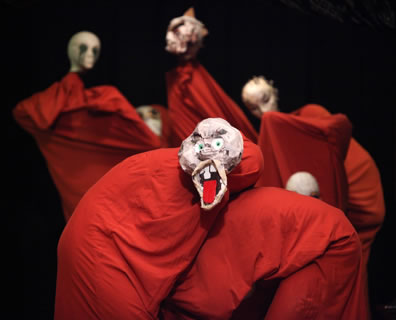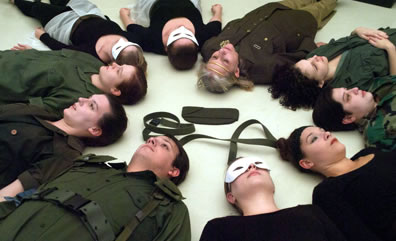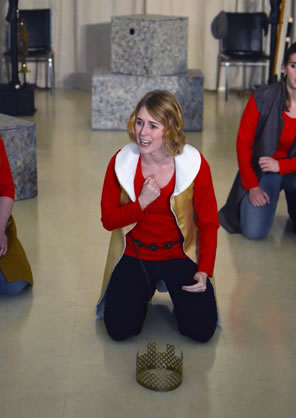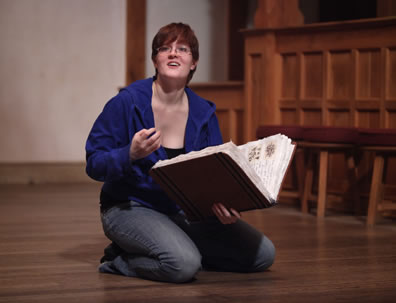Rogue Shakespeare
Early Modern Classic Edutainment
Mary Baldwin College MFA Performance Festival, Blackfriars Playhouse, Staunton, Va.
March 30-April 1, 2014, C-8 (center stalls)

The Seven Deadly Sins in Rogue Shakespeare's production of Doctor Faustus. Photo by Norm Shafer, Rogue Shakespeare.
In the Shakespearean geography, Mary Baldwin College is up the hill a few blocks from the American Shakespeare Center's Blackfriars Playhouse in Staunton, Va. They make good neighbors. The college's Master of Letters/Master of Fine Arts in Shakespeare and Performance (MLitt/MFA) program draws on the ASC for faculty (including ASC's founding director, Ralph Cohen), for internship opportunities, and for guest artists in the persons of some of the professional actors working at the Blackfriars. The program also occasionally get to use a cooler theater space than many other universities in the country. The Blackfriars, meantime, can be assured an enthusiastic, young-skewing audience from the Mary Baldwin student body and faculty for its year-round slate of 17 productions.
This proximity also factors into the unique master's program Mary Baldwin offers, not just in early modern classic theater scholarship, and not just in classic theater performance, but in both combined. Through using ASC resources and the Blackfriars Playhouse, Mary Baldwin MFA students combine academic studies with applied theatrical studies. To earn their Masters of Letters degrees, the two-year students must complete a thesis project that combines a dissertation and performance. In the second year, they can apply for the one-year MFA program.
The program's repertory company, Rogue Shakespeare, comprises 12 MFA students who collaborate to perform, direct, dramaturg, design, choreograph, stage manage, budget, promote, and produce a five-show repertory of early modern and early modern-inspired plays within a single calendar year (along the way they document and write about their experiences). The productions, two of which include guest artists, represent a variety of styles:
- A 60-minute touring education show—this year it is William Shakespeare's Macbeth—which the company takes to schools in the region;
- Two extreme casting shows in which the company is divided into two five-actor casts, this year doing Shakespeare's Richard II and The Insatiate Countess by John Marston, Lewis Machin, and William Barksted;
- A Renaissance show, this year Christopher Marlowe's Doctor Faustus, performed according to the production process of Elizabethan theaters with the actors relying on cue scripts to put the play together in only a few days of rehearsal time without a director or production team;
- The Blackfriars Show, a play specifically designed to use the Blackfriars Playhouse, the world's only re-creation of the indoor theater that Shakespeare's company, the King's Men, operated late in his career. This year's selection is Fuente Ovejuna by Lope de Vega.
The Rogue's capstone event before graduation is a festival featuring all five productions in public performances, and the company invited me to attend the proceedings. I was not able to take in The Insatiate Countess, but I attended the rest with high hopes for Fuente Ovejuna, much trepidation for Dr. Faustus, and keen interest, naturally, in the two Shakespeares. Man, was I in for a surprise.
Macbeth
Rogue member Riley Steiner directs this production specifically meant to be taken on the road with a minimum of fuss and played in tight spaces, if necessary. In her program notes, Steiner describes how the company proposed a variety of contextual approaches to the play, from a rifle drill team in kilts to witches on stilts. "When I began digging deeply into the play, I found that it insists on being, quite simply, a compelling story told through elegant language and complex people," she writes. Thank goodness.

The cast of Macbeth lies in a circle before the play starts. Clockwise from bottom left: Dane C.T. Leasure as Malcolm, Rebecca Hodder as Donalbain, Charlene V. Smith as Macduff, Melissa Huggins as a Weyard Sister, Julia Gayden Nelson as a Weyard Sister, Stephanie Howieson as Duncan, Cyndi Kimmel as Banquo, Kelly Elliott as Macbeth, Celi Oliveto as Lady Macbeth, Jessica Schiermeister as a Weyard Sister. Photo by Kayla Renee Peterson, Rogue Shakespeare.
The contextual framework she settled on is a compelling one: the connection between storytelling traditions of Scotland and Appalachia, which was largely settled by Celtic immigrants. Upon entering the theater, we find the company of 11 actors wearing modern military battle fatigues or in black leotards and leggings (costume design by Celi Oliveto) lying on their backs in a circle, and we are invited to take seats around the troupe. The entire play is performed in this circle, with the actors transitioning through various parts in rapid sequence. Such is the pace of the piece and so unobtrusive are the cuts that even though the play is over in one hour, we feel we've seen the whole composition (the only cuts I easily discerned were the Porter's extended knock-knock jokes).
A total of 23 roles appear in this 60-minute telling, with only Kelly Elliott and Oliveto playing one part each, respectively Macbeth and Lady Macbeth. Oliveto's Lady Macbeth is clearly the aggressor of the couple and displays her ambitious bent up to her sleepwalking scene, even looking back at members of the audience with knowing glances at key points. Cyndi Kimmel's Banquo is very much the trusting friend, but he suspects Macbeth immediately upon the latter recounting how he killed the two servants fingered for murdering Duncan. Kimmel wears a white mask when appearing as Banquo's ghost during the banquet scene.
Such are the special effects of this bare-bones production, but the sound effects are much more haunting, as those around the circle not taking part in dialogue hum, moan, whistle, sing, blow like the wind, tap various devices, play various instruments, and create noises in other ingenious ways, such as playing a Tibetan singing bowl. Though at times the noises crowd out the play's lines, the sound effects provide the supernatural feel of the production and reflect the inner turmoil of the Macbeths' psyches.
Fuente Ovejuna
When England's theater industry was flourishing around the turn of the 17th century, Spain likewise was entering a golden age of drama. Lope de Vega, Spain's pioneering playwright and one of that nation's most prolific, was a contemporary of Shakespeare. Several years ago, I saw his The Dog in the Manger at the Shakespeare Theatre Company in Washington, D.C., and it remains one of the most delightful plays I've seen that theater do. I was looking forward to seeing more de Vega, this one in a translation by G.J. Racz and helmed by guest director Beth Burns, artistic director for the Hidden Room Theatre in Austin, Texas.
It's a rambling piece of work about a military commander, Fernán Gómez de Guzmán belonging to the private army of a Catholic sect and living in the town of Fuenta Ovejuna. The commander had some sort of sway with the town's mayor, though I didn't fully understand their relationship, and he kept going off to lay sieges or lift sieges of other nearby towns in service to the Catholic monarchs of Queen Isabel of Castile and King Ferdinand of Aragon (yes, the pair who historically funded Christopher Columbus's voyages, though Burns sets her production circa 1613 when de Vega wrote the play).
Guzmán (Steiner in a proud yet slimy portrayal) is a bully who sees himself as the ultimate ladies man, and an entitled one at that, so forces himself on all the village women; if they resist, he rapes them and then passes them around among his soldiers. Any village man who intervenes is beaten, and one, Frondoso (Dane C.T. Leasure), the betrothed to Laurencia (Kimmel), is arrested and sentenced to hanging for interfering with Guzmán's assault on Laurencia. The men of the village are too scared to act until the violated Laurencia berates the male authorities into action and forms her own army of women. They set out to rescue Frondoso, and in the ensuing skirmish, Guzmán and some of his followers are killed, except one who escapes to report the revolt to Isabel and Ferdinand. They send a judge to try the case, but the villagers all band together and agree that they will not single out any individuals but claim that the murderer is Fuenta Ovejuna, i.e., the town itself. King and Queen eventually accept that the townsfolk were fighting back against Guzmán's tyranny and grant the village freedom.
Based on a true story from 200 years earlier, this early 17th century play does have a modern parallel, though not one the production explores. In 1981 in Skidmore, Missouri, a town bully who was countless times arrested for violent acts but always somehow beat the charges, was murdered when a mob of residents teamed up in a spontaneous attack. Despite the number of witnesses to the crime, which took place on the town's main street in the middle of the day and with the bully's wife present, authorities could get no one to finger any individuals and no charges were ever brought.
Burns decides to let Fuente Ovejuna stand on its own, but the script itself seems unable to find a relevant toehold and struggles to navigate through the play's twisting strands of tragedy and comedy. The clownish villager Mengo (Elliott), for example, is considered a coward and dunce, but he's one of those whipped by Guzmán for intervening in the rape of one of the women; afterwards, he keeps protesting how his back is now as pink as salmon steak.
Nevertheless, the production does accomplish its aim of showcasing the Blackfriars, especially with the use of the gallery above the stage for the ever-present musicians who provide musical interludes throughout the play. Fuente Ovejuna also highlights the costuming talent of company member Melissa Huggins who designed the elaborate, 17th century clothing, including a gorgeous golden gown she wears as Isabella that appears as if it had apparated directly from a 15th century painting of the queen.
Richard II
Charlene V. Smith is honing in school what she already has accomplished on the public stage. As cofounder of Brave Spirits Theatre in Washington, D.C., she directed a 10-actor Richard III that proved to be an effective rendering of that play. Now she's taking on the more elegiac Richard II with a cast of five.

Jessica Schiermeister as Richard II upon his return from Ireland. Photo by Kevin Hollenbeck, Rogue Shakespeare.
Jessica Schiermeister plays the title role and doubles as a servant to York while Mary Beth Geppert, Stephanie Howieson, Rebecca Hodder, and Julia Gayden Nelson tackle the production's other 29 roles. Early in the play, Smith has the actors in unison speak a character's name to identify them for an audience, but she drops this device after the first few scenes. The cast uses cloak vests that can be turned inside out, scarves, and other accoutrements to distinguish their several characters (Hodder is credited as the production's designer). Smith shows particular spunk in maintaining the gage scene when various lords challenge each other in Parliament before Richard's deposition. The scene requires interchanges among six individuals but is carried out by just three actors as Nelson playing Bolingbroke watches over the whole proceedings while Richard remains offstage until called upon to relinquish his crown.
In one interesting textual shift, Smith turns Richard's final meditation at Pomfret into a play-opening prologue. It makes some sense in and of itself as Richard recounts his fall at the hands of Bolingbroke in that speech, but it is totally suitable for this particular production with Richard's line that "Thus play I in one person many people, and none contented." Sure, Scheirmiester pretty much plays only one person in this play, but as she is giving this speech she is performing extensive choreographed movements in conjunction with the rest of the troupe, the five becoming one entity before they individually become many.
Less effective is Smith's decision to intercut the murder of Richard with the play's final scene of Bolingbroke holding court as first the news of the crushed conspiracy and then the murdered body of Richard arrive. Smith apparently wants to exploit parallel lines the once and present kings speak, as they both exclaim the assassin's name, Exton, in unison. "Exton, thy fierce hand hath with the king's blood stained the king's own land," says Richard with his dying breath. "Exton," says Bolingbroke as the assassin presents his deed to the new king, "I thank thee not, for thou has wrought a deed of slaughter with thy fatal hand upon my head and all this famous land." Insightful, maybe, but the price of pointing out this parallel is confusing action on the stage with three actresses playing both the team of murderers at Pomfret and the news-bearing lords at Windsor. At least Smith keeps Exton as the murderer instead of transplanting Aumerle to the deed as was done in the previous two productions of Richard II I've seen, and I'm grateful to her for that as I don't like directors making more of Aumerle than is really there, historically or in the play.
Doctor Faustus
Marlowe's bombastically pretentious account of the German scholar who makes a pact with the devil for 24 years of magical powers and superior academic credentials over his peers is not on my list of preferred nightcaps to a busy day of theater. And to be totally frank, as this was an exercise in Renaissance-production-process, I worried about how the inexperienced troupe of actors en-route-to-their-MFAs would carry it off.

Dr. Joan Faustus (Charlene V. Smith) gushes over the possibilties in her great necromantic book in Christopher Marlowe's Doctor Faustus at the Blackfriars Playhouse. Photo by Norm Shafer, Rogue Shakespeare.
Doctor Faustus turned out to be the festival highlight for me, and for right reasons. With Smith in the title role, the acting is solid. The Rogues also not only set the play in modern dress, they reverse-gender it with Smith playing Dr. Joan Faustus. This adds a gender equality aspect to the ambitious scholar's motivation as she desires most of all to surpass her male colleagues in prestige. It also provides some cheeky fun as two of the devils, guest artists Scott Campbell and Ian A. Charles, appear to her as lewdly masked male strippers. In addition to attaining great powers and knowledge, Smith's Faustus also attains a good sense of fashion, too, after the devils strip off her sweatshirt jacket and replace it with a form-fitting leather one. With each appearance, Smith's Faustus sports new, more elegant wear—necklaces, blouses, boots.
The company also uses masks and puppetry to portray the residents of hell, except for Mephistopheles (an ever put-upon Leasure dourly executing Faustus's orders but obviously just biding his time). The parade of the seven deadly sins is engrossing as the actors, wrapped in red sheets and wearing thematically appropriate masks, move through their speeches in such a way that they become personifications, individually, of Pride, Covetousness, Wrath, Envy, Gluttony, Sloth, and Lechery.
The company's boldest endeavor, however, proves to be the production's highlight and one you rarely see attempted even by the professional ASC actors on this very stage: whole scenes improvised. Says the program notes: "Nelson [who plays Wagner, Faustus's apprentice] chose to use practice-as-research to explore a theory that the A-Text of Dr. Faustus shows signs of improvisation." Thus, over the course of three previous stagings, the clowns—Nelson, Kimmel as Robin, and Huggins as Rafe—gradually moved from exact line readings to various degrees of improvisation. For this performance, they deliver their scenes almost entirely off-the-cuff. One would think that moving from Marlowe's blank verse to millennials' slacker talk and then back to Renaissance language would be jarring, but it feels genuine to the play. Furthermore, it certainly is more accessible to the audience, and a heckuva lot of fun, too.
That, ultimately, is the point and purpose of Rogue Shakespeare's MFA Performance Festival: it's all a learning experience, for us in the audience as much as for the students on stage. It's also a theater experience, in which your entertainment is their education.
Eric Minton
April 7, 2014
Comment: e-mail editorial@shakespeareances.com
Start a discussion in the Bardroom



 Find additional Shakespeareances
Find additional Shakespeareances